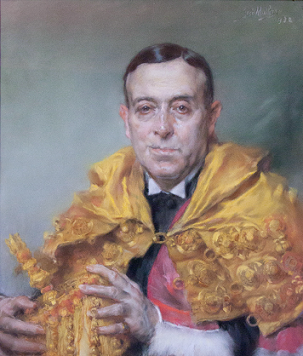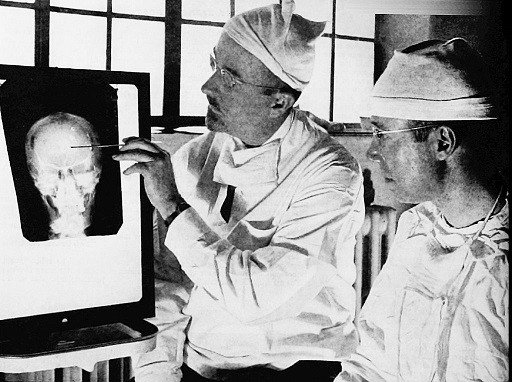No great mind has ever existed without a touch of madness.
- Aristotle
There are great scientists whose superior minds propelled mankind into new heights. The likes of Einstein, Crick, Watson and Darwin have earned their place in history. Among the great names of science, are some who significantly improved the lives of millions, and also caused death and devastation. With this new series I want to introduce very controversial scientists and shed some light on their doings, good as well as evil. Some of them are unknown to the broader public, while others are present in everyday life. With this new series I want to combine my love for science with my passion for history.

Antonio Egas Moniz - When Intentions Go Wrong
There is little doubt any physician has influenced pop culture more than Dr. Egas Moniz without gaining major fame. He was the inventor of one of the most infamous surgical procedures in history. But let me step back and talk about how he became a famous physician.
Egas Moniz came from an aristocratic family in Northern Portugal and was educated by his uncle before he entered the University of Coimbra's faculty of medicine (1). He graduated in 1899 (2). He then went on to deepen his studies in Bordeaux and Paris (1) before returning to Coimbra as a professor. In 1911, he transferred to Lisbon to be the first head of Neurology (3), a position he held until 1944.
While Egas Moniz was one of the figureheads in the establishment of neurology and psychosurgery, he also spearheaded the development of one of the most controversial procedures in medical history - lobotomy - for which he later was rewarded the Nobel Price (1, 2, 3).
Lobotomy
Lobotomy has been in the making for a long time. First experiments were performed on animals by Burkhardt, who operated on dogs, and Fulton, who operated on chimpanzees (4). Fulton had sparked the idea in Egas Moniz to perform similar procedure on humans (1). Egas Moniz first lobotomy was performed by drilling two holes into the forehead of the patient, through which pure ethanol was inserted into the head (4). The procedure was considered a success, with the patient having decreased symptoms and being more controllable (4). From Egas Moniz's first procedure, lobotomy has gone a long way, and many lobotomies have been performed between 1935 and the 1950s (5). Lobotomy has been criticized early on, but nonetheless, Moniz received the Nobel prize in physiology in 1949 (2, 5)

Ethical Implications
Lobotomy was not necessarily intended to heal the patient, but rather to make them "controllable"(4). It could be argued that lobotomy was used to bring relieve to the people who were responsible of the patient, rather than the patient itself. Data also shows that lobotomy was mainly performed on women (5). Often, parents sent uneasy children to have a lobotomy performed. Being an average child who, like most boys at age 12, got into fights with his brother, Howard Dully was given a lobotomy (6). While Dully survived and is not crippled, many were not as fortunate. Rosemary Kennedy had low intelligence and would be aggravated very easily. In 1941 a lobotomy was performed on her and she ended up crippled and never fully functional again (7). Like these two patients, many patients did not consent to the procedure. Cases can be easily found online. It is questionable whether lobotomy actually brought about positive changes. Additionally, many conditions can now be treated with pharmaceuticals. For example, bipolar disorder can be treated relatively easily with medications (for example lithium).
Egas Moniz - Genius or Mad Doctor
Personally, I believe Egas Moniz had very good intentions. However, he did rush his first procedure and sparked a movement that has ruined many lives. Egas Moniz did not anticipate patient's to be harmed and the parents of the affected patient's are to be blamed since they were looking for an easy fix for children who were harming their reputation or ambition (7). Movies have portrayed lobotomy patients as will-less zombie-like people (for example in Shutter Island). However, many patients went on to live relatively normal lives.
What are your opinions?
Do you think Egas Moniz was a mad doctor? Or was he a forward thinker, whose discovery spun out of control?
Please leave your comments below!
Thank you for reading the second part of my series! If you enjoy this, please upvote. If you have found something you do not agree with, please comment. The same applies to suggestions. I want to become a good writer and make valuable contributions to Steemit. But I can only get better with your suggestions!
Also check out my blog for my series about chemical instruments.

Cheers @lesshorrible!
Good article on the lobotomy. Today I would find it totally unethical. Most likely It would have been considered unethical even at the beginning of his work. No doubt Dr. Moniz had good intentions, but perhaps did not realize the consequences of his work. Very interesting.
Downvoting a post can decrease pending rewards and make it less visible. Common reasons:
Submit
Hey @mother2chicks. Thank you very much for your comment! I think this goes a little into the direction of mind control, and we know how many conspiracy theories are out there! Cheers!
Downvoting a post can decrease pending rewards and make it less visible. Common reasons:
Submit
Downvoting a post can decrease pending rewards and make it less visible. Common reasons:
Submit